Spring Outdoor Core Stability & Mobility Exercises
How exciting that spring has arrived and it means we can get outdoors more and exercise in nature’s playground. It also means endurance athletes are ramping up their spring training programs for races and the everyday exercisers are feeling more motivated to get back into their exercise routines. So to aid that spring in your step, I wanted to share some exercises you can do outside as part of your walk, run, park time, or cross training. They do not require any equipment except the most important machine ever made, your body!
Core Stability and Mobility Exercises are Foundational to a Strong Body & Performance
Contrary to popular tabloid, social media, and mainstream promotions, did you know that you are only as strong as your core? Furthermore, are you aware that before you even start strength training or strength exercises, you need the foundations of mobility and stability. In fact you can prevent injuries and increase your sport performance by doing mobility and stability exercises weekly.
The pathway to a strong body that will support your endurance sports, everyday activities, and also optimize aging are as follows:
- Mobility
- Stability
- Strength
The best course of action if you are an endurance athlete or even a weekend warrior who does long hikes or walks is to follow this sequence of steps first: mobility, stability, strength. Only after these steps should you add in endurance. You need to start here to give your body the support it needs for your endurance activities.
What are Mobility Exercises and Why do you Need them?
Mobility means having healthy range of motion around your joints, but it also means your body moves as it is meant to efficiently and pain free. Mobility extends beyond one joint to how your body moves as a system and when you have mobility, it enhances your peak performance.
One of the best, simple analogies I ever learned to explain this concept further is as follows:
If you have a tight muscle, this ‘shortened’ muscle not only restricts the joint upon which it is attached limiting the range of motion at that joint, but also, a constricted muscle cannot generate maximal power.
If your mobility is limited anywhere then the following are affected:
- You will not have full range of motion and therefore less function and power
- Muscular imbalances are created which could lead to injury or pain
- Lack of mobility in one area will affect the rest of the body and its optimal function
Mobility Exercises to Keep You Flexible, Optimize Function, and Increase Power
- Hip Flexor Opener
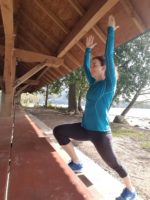
2. Hip Flexor, Hamstring, and Ankle Mobility Forward Push and Downward Bend
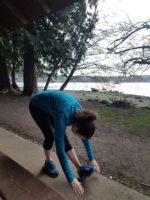
3. Lateral Hip Shift and Side Bend One Leg up on Bench
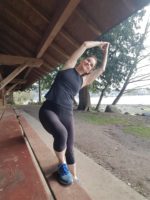
Core Stability Exercises for the Everyday Exerciser and Endurance Athlete
Having been a certified ACE Medical Exercise Specialist for 15 years and specializing in post rehabilitation exercise, I have learned a lot about the human body and common causes to injuries. For instance, I have seen numerous long distance runners experience injuries or pain in their low back or knees due in part to weak core stability. So how is stability different than strength?
Stability has to do with muscles being able to stabilize a joint or joints while you are moving and placing demands on it. The way I like to think of stability muscles is that they are the ones closest to your joints and they are often the small forgotten muscles, but the mightiest because they act as a fortress of strength and guidance around joints. Stability muscles need to be able to stabilize you for the whole time you are placing demands on your body; therefore, they need to be trained for endurance.
Core stability muscles are the muscles found near and responsible for supporting your pelvis, trunk, back, and hips.
“Often it is not the big muscles we need to strengthen to get to our peak performance and optimal function, but the forgotten core stability muscles that are way more powerful long term. They truly are your competitive edge, injury prevention, and secret sauce to optimal function.”
Everyone thinks ‘core stability’ refers to abdominal muscles only, but core stability muscles include muscles that stabilize the hips and back.
The gluteus medius muscle is a core stability muscle. If it is weak, it can contribute or be a main cause for: knee pain and injury, pelvis instability leading to low back pain, and muscular imbalance. This seemingly insignificant muscle to us even impacts the way our foot strikes with walking and running. Every walker, hiker, runner, biker, okay everyone, needs to strengthen their gluteus medius muscles.
Stability Exercises and Core Stability Exercises You Can Do Anywhere
Of course if I was giving you a core stability strength training program, it would be personalized to your body, your sport, and the demands of your day. However, there are some common stability exercises that are great for everyone and can be done outdoors, in your home, or at the gym.
What stability exercises are most important for everyone and which ones do I need to focus on for core stability?
It is super important to learn this concept of shifting from the sole focus of strength training being on the big muscles to the super important core stability muscles. Your stability muscles are the key to your body feeling great and amazingly powerful.
There are some stability exercises that everyone should incorporate into their weekly training program and that we all need. The following is a list of the main stability muscles we need to work and strengthen: (see exercises to match these muscles below)
- Pelvic Floor and Transverse Abdominals
- Gluteus Maximus
- Glutues Medius and Minimus
- Erectore Spinae
- Quadratus Lumborum
- Vastus Medialis
- Ankle and Toe Flexors and Extensors
There are many exercises at all different ability levels to begin using these muscles and develop your stability. Below I include stability exercises you could begin doing in your weekly exercise routine. They are at a moderate ability level. Please know your level of ability and listen to your body. Only perform these if you have no injuries or pain.
Stability Strength Exercises for a Strong Body
These are for people who already have a base of core activation and strength in their pelvic floor and deep abdominal muscles.
Here are a few core stability exercises you can do anywhere to get you started:
- Plank with Hip Extension
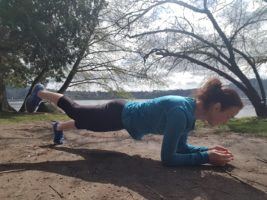
2. Side Plank with Side Leg Raise – The Star Fish (beginner start with bottom knee bent)
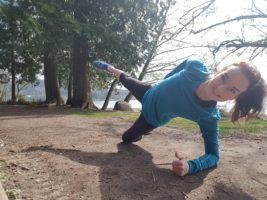
3. Rock the Boat Plank – Hip Sway side to side
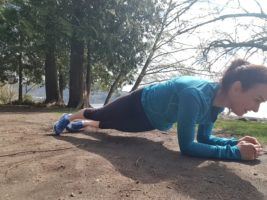
4. 1 leg Bridge Lift
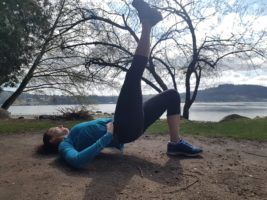
5. 1 leg Dip Squat
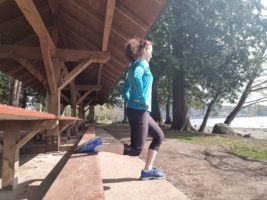
Have fun with these and give them a try starting with one set of 10 reps to begin and build up to 15 repetitions of 2 sets gradually. The technique of exercises is important so you do them effectively which can be demonstrated by a personal trainer. It is also important to have a core stability and strength program designed specifically for your body, health history, and goals.
Time to get outdoors, loosen up with mobility exercises, and start training your core stability muscles. Happy training. Jody
About Jody Kennett
 Jody Kennett has been a personal trainer serving North and West Vancouver for 20 years now. She is an ACE Medical Exercise Specialist with a diploma in Kinesiology from SFU. As additional growth from training people physically for years, she has ventured into a variety of coaching certifications and disciplines including: GAIA Leadership Coach, C-IQ Certified Coach in the neuroscience of communication, and business coaching.
Jody Kennett has been a personal trainer serving North and West Vancouver for 20 years now. She is an ACE Medical Exercise Specialist with a diploma in Kinesiology from SFU. As additional growth from training people physically for years, she has ventured into a variety of coaching certifications and disciplines including: GAIA Leadership Coach, C-IQ Certified Coach in the neuroscience of communication, and business coaching.If you have questions or would like a personalized exercise program you can reach out to Jody at [email protected].
If you enjoyed this article, read more from Jody Kennett: Peak Health, Wellness and Energy for 2019
